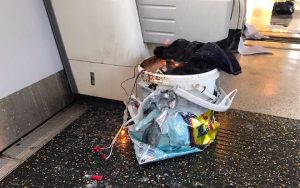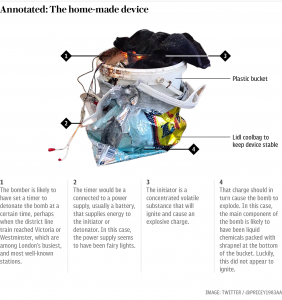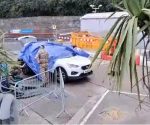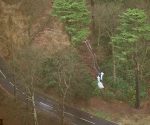Parsons Green terror theatre: using redeployed Mid-East battlefield assets?
All the evidence suggests that the incident at Parsons Green on 15/9/17 was a drill that went live (and became a hoax when it was pronounced to be a terror attack), but suffered from the fact that the “crime scene” wasn’t isolated from the public so that images of reality could be sneaked out into wider circulation: in short, the Establishment lost control of the narrative. As such, a damp squib out of a bucket looks a pretty feeble excuse to have the military and armed police patrolling the streets; hence, the author suggests, the hasty reversal of the terror alert status from critical to severe. That being said, none of the failure stopped the corporate-media running with the script – what had been prepared as incontestable fiction (as per usual) turned into bloody minded gaslighting in spite of reality; the corporate-media doesn’t care about its integrity because it never suffers for the lack of it. Some internet researchers have noted that certain people with demonstrable connections to crisis planning and indeed possibly acting have featured in the corporate-media’s attempt to build a fantasy, and say that this in itself shows that the incident was crisis theatre. Let’s just say that it is circumstantial evidence: lots of people in the crisis staging and related industries work in London and need to commute of a morning. The real key to comprehending the incident for what it is is seeing how the corporate-media and government’s narrative cannot measure according to the gauge of what we can see and inspect with our own eyes, nor to what we must conclude when we apply our own critical thinking about that evidence.
Take for example how we are still told in the corporate-media that a “bomb exploded” on a train at Parsons Green station. This is patently not true. A bomb did not explode, and the images collected by a vigilant citizen provide the evidence to support that statement. The reader can see footage taken of what must have been the recent aftermath by following the link.† In fact, there is no evidence in the images to tell us that the white builder’s bucket and its contents constitute a bomb at all. However, the authorities claim that it does, and by doing so have to concede that it is a bomb that has not exploded by dint of the fact that it remains very much in the pristine condition it was in when it was placed on the train; the government, the Metropolitan Police and the corporate-media cannot have it both ways. And yet they all try to by modifying the storyline to tell of a partial explosion – by which we must presume them to mean a detonator that failed to ignite the rest of the bomb.
The corporate-media, in its accounts, insist that a fireball “ripped” through the carriage, and this caused a few incidents of casualty by burning. However, the corporate-media also hints at TATP being the explosive used (because TATP fulfils the role of explosive most likely to be concocted by an amateur in the public imagination). But, if we apply some background knowledge to this information, we understand that TATP as a detonator could not cause a fireball. Let’s go at this in steps:
TATP is very hard to make, despite what the corporate-media tell you. It has to be refined to become explosive – and it looks very much as if one needs to have certain laboratory-grade equipment to do this. It needs refrigeration thereafter to keep it from evaporating (perhaps we are meant to believe that the insulated Lidl bag was somehow meant to keep the substance in the bucket stable). These real requirements for producing and storing TATP should perhaps rule it out as being number one choice of explosive material for wannabe backstreet bomb makers. It is extremely volatile and if budding amateurs were really whipping it up all the time to use in terror plots we should perhaps hear about more killed in premature explosions. In the real 7/7 London terror story, as pieced together by Nick Kollerstrom, the idea that TATP was used had to be faded out into a fudge, such was its improbability.
And yet, still, the corporate-media hints at TATP being used at Parsons Green, although the Mirror, amongst others, goes ahead and makes an outright claim:
The deadly homemade device, which was filled with explosive TATP, was probably put together using items from high street shops
Now we’ll let a BBC analyst take us through the next step of appreciation:
The Parsons Green device is also understood to have had some kind of timer and the fairy lights are apparent from the pictures.
Some of them have what looks like a white plug at the end which could be wax.
This approach has been previously used to seal bulbs after they have been modified to be part of a bomb. Zahid Hussain, a Birmingham man convicted in May of trying to make a crude device, did exactly this.
Other intelligence tells us that Zahid Hussain used fairy lights as a detonator. Now consider the following, which is a MailOnline story that was written at the time of the trial of the July 21, 2005 London terror plotters. It states how the filament in a bulb exposed to TATP can supposedly work as a detonator:
The TATP was put in a cardboard tube together with a torch bulb which had a hole in it to allow some of the TATP to come into contact with the filament. The bulb was then connected via 80cm long wires, hidden inside the bombers’ clothing, to a battery and two snap connectors, which would act as the trigger switch when pressed together.
By completing a circuit, the bulb would light up, ignite the TATP and trigger and detonate the chemical mixture in the plastic tubs.
In actual fact, the author has seen it claimed that the Parsons Green bomb also had other types of explosive for the main body (see the diagram from a Telegraph article below, and click to enlarge), but the point is that in the public imagination of home made bomb building, the Government has established that TATP is used by terrorists in light bulb detonators.
The images of the Parsons Green bomb (some of which perhaps we weren’t supposed to have†) suggest that this is the way that it too was contrived. And yet TATP does not produce heat or light when it explodes – so if we believe the story of the “ball of flame” partial explosion, then TATP probably wasn’t incorporated into the detonator. As the Establishment’s story develops, please look out for the corporate-media and the government not getting its story straight about what the bomb was made of. If we don’t believe the ball of flame story – and the author doesn’t – then we might take an educated guess that there was nothing about the “bucket bomb” that would enable it to explode at all. And so also look out for the corporate-media and the government trying to sell you a highly unlikely tale about the genesis of the “bomb”. The suspect supposedly lives in the foster home of an MBE-winning foster family – where one can’t imagine a bomb factory being facilitated.
The second element of danger for potential victims at the incident was that which came in a supposed stampede that happened, so we are told, when passengers rushed off the train and towards a single exit at the station. And yet there is footage on the internet (linked to above) showing quite a crowd of passengers milling about on the platform next to the train while it still holds the bucket bomb. One passenger makes a remark about a bag being on fire. None of this resembles the supposed panic that we have been told about.
In another video on Youtube, a witness by the name of Emma Stevie makes interesting comments that reinforce the notion that the incident was a pretence: that the bomb was merely a prop, and any uproar and alarm was caused by people pretending that it had gone off. “The loudest scariest screams” says Stevie, were coming from an adjacent carriage. She also told of “loud men shouting run”. So here what she appears to be describing are agents directing the operation – loud men – setting off the panic. The carriage doesn’t have to be full of crisis actors to create the situation Stevie describes – it just needs people on the ground to inject the belief that there is something to be distressed about (and our extensive study of false flags at this site shows that this is a usual feature). Emma Stevie also says that “we didn’t hear an explosion”. This is because there wasn’t one. The crush that Emma Stevie speaks of may well have happened in some very first instance – as any occasional provincial visitor to London can attest to, Londoners apparently like to be abused on a daily basis by train operators who obviously think they are cattle.
There is no surprise that the police have not released CCTV of the suspect delivering the “bomb” on the train. What we have had, though, are the preposterous images of a man with his head wrapped up carrying a Lidl bag allegedly outside and nearby the property of the foster parents in Sunbury on Thames. Going by previous false flags and hoaxes, there is every chance that this footage was concocted after the event – there would be every opportunity to stage the scene when the street containing the foster family’s home was sealed off, and neighbours were evacuated by police over the weekend. This in itself was a development of the police state that we should all be very concerned with (notice that some, who should be concerned, are proving themselves frauds and calling for more police powers).
We also note that the two suspects that have thus far been arrested are supposed to be refugees from Syria and Iraq – that they are linked with the Sunbury foster home suggests that they came to country as “children”. Not so long ago, of course, there was a big scandal related to grown men taking advantage of a scheme to allow unaccompanied refugee children to enter the UK. It wasn’t long before stories were emerging that “two-thirds” of these kind of immigrants were actually adults. The author identified the whole operation for what it probably really was: the disguised movement of battlefield assets belonging to the US/UK intelligence agencies’. The author conjectures that we aren’t being shown an image of the 18 year old suspect who was apparently arrested trying to flee to Calais because of how he might look much older than his stated age. Of course, the fact that these are Muslim immigrants are coming from lands where ISIS is some kind of mighty military force in the imagination of corporate-media consumers is being played upon by the usual suspects – Breitbart news – assumedly to whip up the race war that the British Establishment apparently longs for. Naturally, there is very little reference – anywhere in big media, alternative or corporate – to how it is usually the case that the terrorists who are labelled such when they come to the UK have in previous lives been operating on behalf of the US and UK when they were in Syria or Iraq.
† There is still image of the bucket available on the internet that shows something different to the moving image linked to in this article. The latter sho ws the Lidl bag on fire.
ws the Lidl bag on fire.
We can then suppose that the still image was taken before the film footage, and we must ask ourselves if there is anything in that still image which would set alight to the plastic bag that the bucket sits in? If we can’t answer that question, we have to conclude that the bag was seperately and manually lit on fire.
Please note, the Telegraph has been naughty in creating the image for its illustration (see half way up the page) because it has left out a number of illuminated fairylights which might inform the viewer that the orange glow at the top of the bucket is also lights – not flame.



















